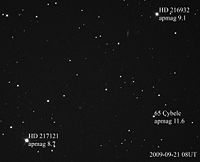Apparent magnitude

Apparent magnitude is a way of measuring how bright a star, planet, or other object looks from Earth. To measure the apparent magnitude of an object, we use a number called a "magnitude". A lower magnitude means the object looks brighter. For example, the brightest stars in the night sky (like Sirius and Vega) have an apparent magnitude of about -1 or -2. On the other hand, a faint star or planet might have a magnitude of 5 or 6. Apparent magnitude does not measure the actual brightness of an object, but rather how bright it appears from Earth.
Related topics others have asked about:
